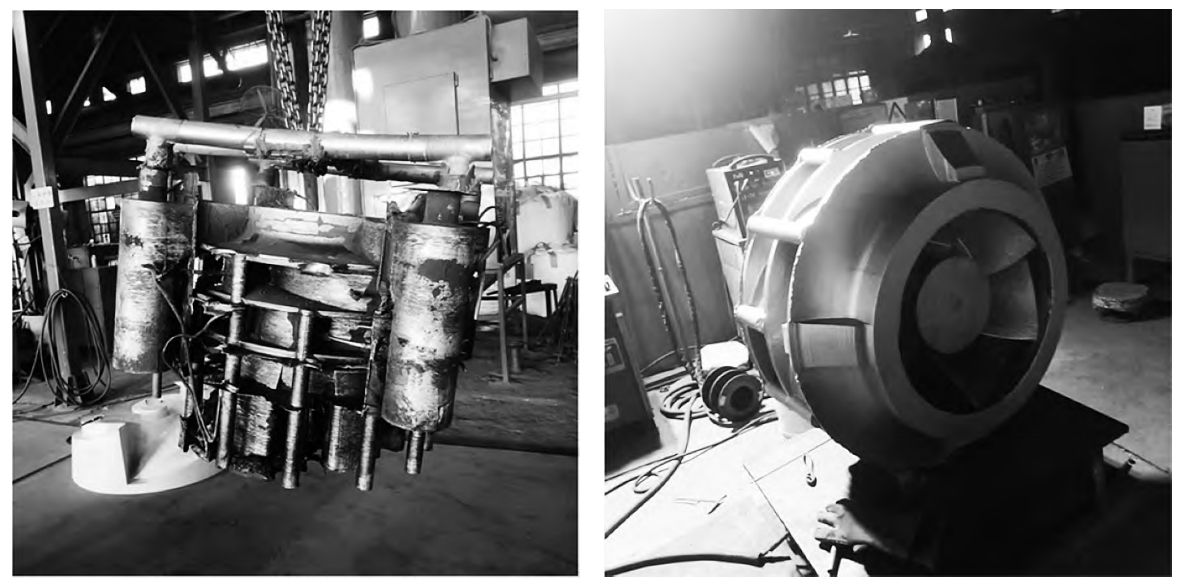Abstract:
This research focuses on the casting process of a double-suction impeller made from C95820 aluminum bronze, a material characterized by its large size, uneven wall thickness, and complex structure. Traditional casting methods face challenges in producing such parts due to defects such as concentrated shrinkage porosity, oxide inclusions, and porosity. This study leverages the technical advantages of sand mold 3D printing, utilizing ProCAST software to optimize and design the gating and riser system. This innovative approach ensures smooth filling of the molten metal, with shrinkage porosity defects primarily concentrated in the gating and riser system. Furthermore, the key blade sand core, which affects the accuracy of the impeller, is designed and printed integrally, incorporating conformal air ducts to facilitate the rapid discharge of gases generated during the casting process. The successful pouring of the 3D-printed sand mold results in the production of a high-quality aluminum bronze double-suction impeller casting. This research demonstrates the feasibility and advantages of applying sand mold 3D printing to impeller casting, contributing to advancements in the field.

1. Introduction
Double-suction impellers are turbomachinery equipment featuring two suction inlets, commonly used in high-flow and high-pressure fluid handling systems such as pumps and compressors. Compared to traditional single-suction impellers, double-suction impellers offer larger flow rates and higher efficiency, making them widely used in industries such as energy, petrochemicals, and water treatment.
Aluminum bronze, with its narrow crystallization temperature range, good fluidity, and resistance to compositional segregation and dispersed shrinkage pores, is suitable for manufacturing dense castings, often used in gears, turbines, shafts, propellers, and other applications. However, aluminum bronze is prone to forming oxide inclusions and porosity during melting and pouring, and it experiences significant shrinkage during solidification, leading to defects such as concentrated shrinkage pores and slag inclusions.
The application of 3D printing technology has revolutionized traditional sand casting. Compared to traditional processes, 3D printing offers significant advantages in terms of high quality, short cycles, and low material consumption. Moreover, 3D printing technology is no longer limited by traditional molding methods, enabling the free design of sand core schemes and gating and riser systems. The production process of casting sand molds becomes more streamlined, significantly shortening the production cycle and reducing manufacturing costs.
This paper presents a detailed study on the casting process of a double-suction impeller using sand mold 3D printing technology. The specific research content and structure are organized as follows: Section 2 analyzes the structural characteristics of the double-suction impeller parts; Section 3 introduces the casting process design, including the gating system, riser design, and simulation of the casting scheme; Section 4 describes the sand mold printing and casting production process; and Section 5 summarizes the conclusions of the study.
2. Analysis of Part Structural Characteristics
The three-dimensional model of the double-suction impeller part studied in this paper is shown in Figure 1. The material of this part is C95820 aluminum bronze, with a chemical composition as shown in Table 1. The part has a maximum outer diameter of 1015 mm, a height of 630 mm, and a central through-hole. The wall thickness is unevenly distributed, with the minimum wall thickness being 5 mm. The internal cavity has a complex structure, featuring two asymmetrical blade layers with a connecting plate width of only 15 mm between them. The upper and lower cover plates are connected to the blade layer connecting plates with a width of 19 mm.
[Insert Figure 1: Three-dimensional model of the double-suction impeller]
Table 1: Chemical Composition of C95820 Aluminum Bronze (w /%)
| Element | Cu | Al | Ni | Fe | Mn |
|---|---|---|---|---|---|
| Content | ≥77.5 | 9.0~10.0 | 4.5~5.8 | 4.0~5.0 | ≤1.5 |
The double-suction impeller has a large diameter and a complex curved surface structure with asymmetrical double blades. The connecting plates between the upper and lower blade layers are thin, which can easily lead to damage to the sand core during demolding and core extraction. In addition, aluminum bronze is prone to oxide inclusions and porosity defects during casting, necessitating a stable rise of the molten metal level. Therefore, the preparation of this part using traditional casting methods presents certain difficulties. To address these challenges,we have adopted the method of sand mold 3D printing for fabrication. This innovative approach leverages the freedom and unrestricted design capabilities of 3D printing technology, enabling the integrated design of critical sand cores, thus preventing the loss of dimensional accuracy. Furthermore, conformal air vents have been designed to facilitate effective venting during the pouring process and to avoid porosity defects in the castings.
In the casting process design, we optimized the gating system by utilizing the ProCAST software, ensuring a smooth rise of the molten metal within the mold cavity and effectively avoiding defects such as oxide inclusions and porosity that can occur during the pouring of aluminum bronze. Specifically, a bottom-pouring method was adopted to ensure a stable filling of the mold cavity with molten metal, rapidly filling the cavity to prevent air inclusion, oxide formation, and cold shut defects.
Additionally, to address the shrinkage porosity defects identified through simulation analysis, we designed a variety of risers for feeding and shrinkage compensation. These risers were strategically placed to direct the flow of molten metal and enhance the feeding capacity of the risers, improving the quality and integrity of the castings. The simulation results confirmed that the shrinkage porosity defects were concentrated in the risers and gating system, effectively controlling and ensuring the quality of the castings.
Overall, the use of sand mold 3D printing technology has revolutionized the traditional casting process, enabling the successful production of high-quality aluminum-bronze double-suction impeller castings. This approach not only overcame the challenges associated with the complex structure and material properties of the double-suction impeller but also significantly shortened the production cycle and reduced manufacturing costs.
